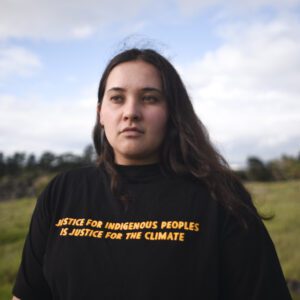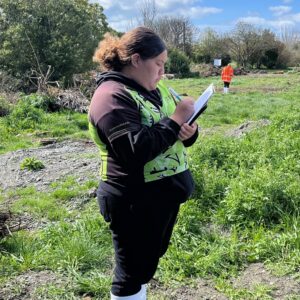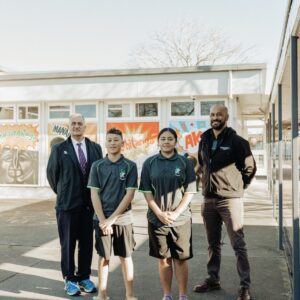



Where I come from, the kererū is revered. A food for royalty and women. Our kaumātua describe how the sky would get dark as clouds of kererū flew overhead, sounding like a loud helicopter as they flapped their wings through our echoing valleys. This memory from long before I was born was a sign of abundance. I imagine our wāhine talking smack with lips covered in fat while they took their share. My father told me that ngahere always provides, takes care of it.
I think about the centuries of understanding that has been harvested on my whenua in Te Urewera. The signs that heralded hard times or good times to come. What valleys to visit for healing, what to listen for on the wind. When my dad and his best friend ran away from school at fifteen to live in the bush, they had everything that they needed. In my whakapapa I am the first link that doesn’t know these things.
The world that we live in is complex, and so are the causes of my own disconnection. But I’ll name a few factors. In 1867 the Native Schools Act was created, and premised on the idea of assimilating a supposedly savage race and beating out of us all of the customs that make us who we are. My dad was a student of a native school and spoke to me about the beatings he got for speaking Te Reo Māori. He never spoke Te Reo to me until I finally begged him into it as a university student. This was six months before he passed. In 1907 the Tohunga Suppression Act was created in response to the movements assembled by the likes of Rua Kēnana. Indigenous medicine outlawed, along with the spiritualities that were woven into it. Our people forced to abandon the health frameworks that had always been the most beneficial to us. In 1954 when my father was ten years old they made Te Urewera a national park. They said it was for our own good and told us we need to take care of the environment. As if we had not already been doing that for centuries. Our people could not eat nor live from these lands anymore, could not harvest rongoā to heal nor rākau to carve. Ways of being that are outlawed soon fall out of practice.
Today, polluted water bubbles forward even from the middle of the middle of nowhere in my home. The contexts in which we have always understood our world are shifting. Our language. Our identity. The places we call home. Once upon a time the kererū made a spectacle of the sky, and now I feel blessed to see one bird on a power pole in the city.
Climate change cannot be understood separately from colonisation. And climate action cannot be enacted separately from indigenous sovereignty. When we understand the international picture of the colonial project we see how lands, waters, peoples and livelihoods became capital for exploitation. And every little action mattered.
Climate change is very much a sequence of emerging environmental disasters. Severe droughts and flooding in Te Matau-a-Māui is climate change. Water quality rapidly declining is climate change. Disappearing islands in the Pacific is climate change. I think we can all understand this. But when you understand how a history of colonial violence in rural Māori communities led to the urban drift of our people in the 60s and 70s, you understand that disconnection from culture and urbanisation is connected to climate change. The rates of Māori youth suicide are linked to disconnection from our healing practices and communities and therefore linked to climate change. Inequitable health outcomes for Māori are linked to climate change.
You will hear scientific research that says we have eight years or ten years, or twelve years before the run-on effects of climate change become unstoppable. This in itself is alarming. But in actual fact, marginalised communities have no years. We are already suffering the consequences and are making plans to adapt. I have taken part in land occupations, youth climate marches, and wānanga all to do with climate change. I’ve made art about it, written about it. I travelled to the United Nations climate change talks in Poland with a group of Māori and Pacific youth called Te Ara Whatu. I returned home to advocate to government and council. I do this because climate change is already affecting our lives deeply.
Young people already have a deep understanding of the world that they have been brought into. They often feel frustrated at being placated by older generations who interpret our very real burden as irrational fear about the future. I encourage you to listen and think how you can help support their journey towards action that will benefit us all. If they want to start a club, or petition council, or spend time with their kaumātua, celebrate that. It’s so important that we have a clear picture of what we do want for the future and feel empowered to act upon that vision.
Some of the most inspiring moments I have witnessed in activism have been at the hands of rangatahi. I think of groups like 4 Tha Kulture and their work connecting climate change to social inequities in their communities in a way that many who have spent decades in the climate scene have failed to understand. I have witnessed a five-year-old lead a chant in a march of thousands. I have seen youth in their art convey realities of climate change and genuinely connect people over a cause that will eventually affect us all. Young people have a real power, and in your critically important roles as guides in their journey, you have power too.
My work as a climate activist very much comes from a place of despair at the colonising history of Aotearoa, and the ways that it has affected my understanding and place in the world as a Māori person. However, no work is sustainable without hope. Let us return to the knowledge of indigenous peoples, because we have always considered ourselves a part of the land and the sea, rather than separate. If our whenua and our waters thrive, so too do we.
I imagine a world where resources are created to be accessible to everyone. Where we are able to practice sovereignty over our kai and know where it comes from. Where fast, safe, sustainable transport methods are available to us. Where thriving lands are prioritised over capitalist greed. Where rural communities are supported to navigate environmental shifts, disappearing shorelines, droughts and floods. I envision a world where we can meet each other kanohi ki te kanohi to share knowledge and story. This world requires radical reinvention from us all, because we cannot fix climate change within the system that invented it in the first place.
I think of the birthright I am not able to inherit, the legacy of kererū and how much they mean to us. It’s not that I hunger to eat the kererū, I hunger for a world in which I can be sure that she and I will not be lost.
Kahu Kutia was born and raised on her homelands in Te Urewera. She is a storyteller, artist and activist interested in kaupapa Māori and climate action work. She is the host and co-creator of the RNZ podcast He Kākano Ahau, which weaves together the stories of Māori in urban places. Photo Credit: Nicole Hunt.
Related Posts

Working at a school on the Chatham Islands demands resilience, innovation and a deep sense of connection. Kirsten McDougall spoke with staff at Te One School to find out what it means to educate in one of the most remote communities in Aotearoa.

At Arakura School in Wainuiomata, Lower Hutt, lunchtime isn’t just about food – it’s about community, connection and learning. Instead of outsourcing school lunches, staff and tamariki grow, prepare and serve nutritious kai together. The entire school gathers each day to share a meal, turning lunchtime into a rich learning experience.

How can educators tautoko and empower young people to feel equipped to lead in the changing climate they will inherit? Researchers from the University of Canterbury and Ngāi Tahu have been working with rangatahi Māori and Pasifika in Ōtautahi to explore the ways ākonga view climate change. Ako finds out about the project.

While many schools and centres were damaged by Cyclone Gabrielle, a few were forced into long-term closure with staff and children having to re-establish elsewhere. Ako talked to kaiako from three different institutions that found new premises, or were taken in by a neighbouring school or centre.